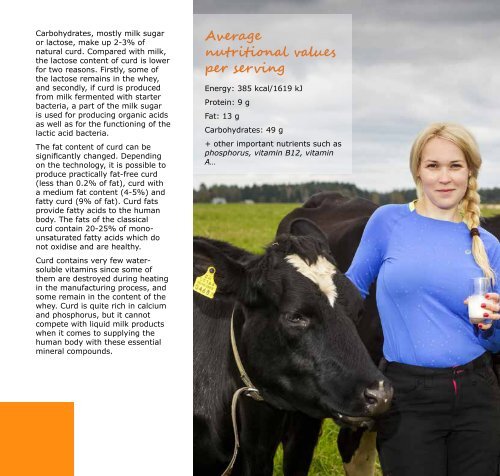Final recipes book
Create successful ePaper yourself
Turn your PDF publications into a flip-book with our unique Google optimized e-Paper software.
Carbohydrates, mostly milk sugar<br />
or lactose, make up 2-3% of<br />
natural curd. Compared with milk,<br />
the lactose content of curd is lower<br />
for two reasons. Firstly, some of<br />
the lactose remains in the whey,<br />
and secondly, if curd is produced<br />
from milk fermented with starter<br />
bacteria, a part of the milk sugar<br />
is used for producing organic acids<br />
as well as for the functioning of the<br />
lactic acid bacteria.<br />
The fat content of curd can be<br />
significantly changed. Depending<br />
on the technology, it is possible to<br />
produce practically fat-free curd<br />
(less than 0.2% of fat), curd with<br />
a medium fat content (4-5%) and<br />
fatty curd (9% of fat). Curd fats<br />
provide fatty acids to the human<br />
body. The fats of the classical<br />
curd contain 20-25% of monounsaturated<br />
fatty acids which do<br />
not oxidise and are healthy.<br />
Curd contains very few watersoluble<br />
vitamins since some of<br />
them are destroyed during heating<br />
in the manufacturing process, and<br />
some remain in the content of the<br />
whey. Curd is quite rich in calcium<br />
and phosphorus, but it cannot<br />
compete with liquid milk products<br />
when it comes to supplying the<br />
human body with these essential<br />
mineral compounds.<br />
Average<br />
nutritional values<br />
per serving<br />
Energy: 385 kcal/1619 kJ<br />
Protein: 9 g<br />
Fat: 13 g<br />
Carbohydrates: 49 g<br />
+ other important nutrients such as<br />
phosphorus, vitamin B12, vitamin<br />
A…


